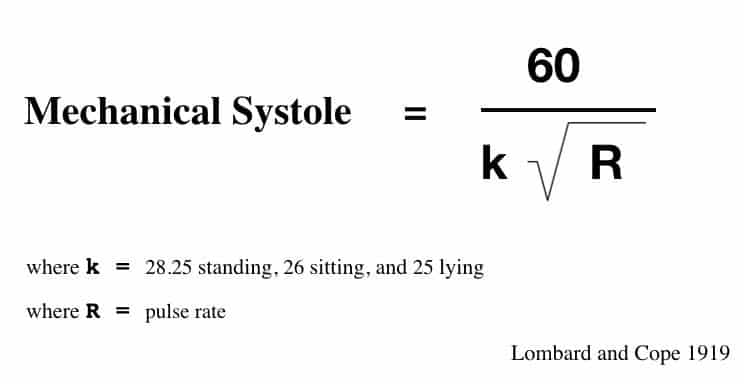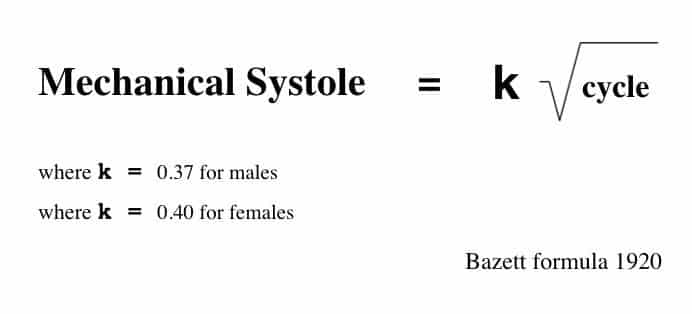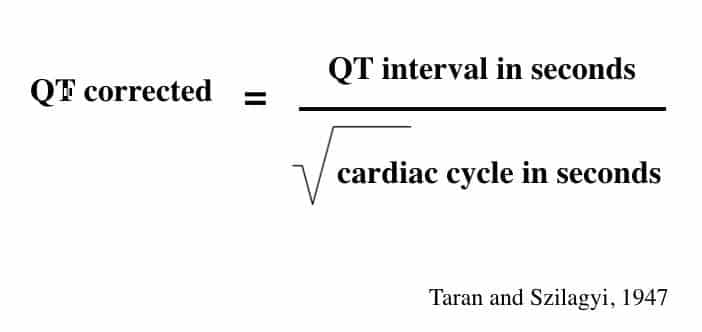Bazett formula
Description
A prolonged QT interval is associated with an increased risk of torsades de pointes. A rise in heart rate is associated with a shortening of the QT interval and similarly a slowing of the heart rate is associated with a longer QT interval.
The Bazett formula ‘corrects‘ the measured QT interval to a value (QTc) attributable to a heart rate of 60 bpm. Thus providing a QT interval value that a particular patient would theoretically have if their heart rate was 60 beats/min

History of the Bazett formula
1891 – Augustus Desiré Waller provided a series of values for the duration of mechanical systole with different heart rates. He demonstrated that the period of mechanical contraction (systole) was shortened at faster heart rates
1919 – Lombard WP and Cope OM recorded measurements of the carotid pulse in patients standing, lying and sitting and following exercise to derive an equation for measuring the duration of systole.

1920 – Bazett used Waller’s 1891 data to create a formula which could estimate/calculate the duration of systole with varying pulse rates. He then reviewed electrical and mechanical data from Weitz, Wiggars, Lewis, Buchanan, Kraus and Nicholai to confirm his calculations. He concluded:
Waller gives values for the duration of mechanical systole with different heart rates, and it will be seen that almost exactly similar figures are obtained by calculation from the formula Systole = k √ cycle, where K has a value of 0.343.
The (Lombard, Cope 1919) results are confirmed by the figures here reported, in spite of the difference in the method employed, and I had independently arrived at the same relationship of systole to the square root of the cycle before the publication of their results.
The duration of the ventricular complex in an electrocardiogram is in the normal heart a function of the pulse rate, and may be determined by the formula: Systole = k √ cycle. The normal value for k is 0.37 for men and 0.40 for women.
Bazet, 1920

1947 – Taran and Szilagyi related QT prolongation to acute rheumatic carditis in children. In doing so, they updated Bazett’s original formula:

Associated Persons
- Augustus Desiré Waller (1856-1922)
- Henry Cuthbert Bazett (1885-1950)
- Louis Sigurd Fridericia (1881-1947)
Alternative names
- Bazett’s formula
- Taran and Szilagyi corrected QT interval
- Bazett formula modified by Taran and Szilagyi
Controversies
Bazett QTc calculation unreliably identifies patients with prolonged QTc interval [Charbit 2006]
At heart rates outside of the 60 – 100 bpm range, the Fridericia or Framingham corrections are more accurate and should be used instead [Framingham heart study, 1992]
References
Original articles
- Waller AD. A demonstration on man of electromotive changes accompanying the heart’s beat. Journal of Physiology 1887;8:229-34. [First ECG in Man]
- Waller AD. Circulation. In: An introduction to physiology. 1891: 52
- Lombard WP, Cope OM. Effect of pulse rate on the length of systoles and diastoles in the normal human heart in the standing position. American journal of physiology, 1919: 139-140
- Bazett HC. An analysis of the time-relations of electrocardiograms. Heart. 1920;7:353-70.
- Taran LM, Szilagyi N. The duration of the electrical systole, Q-T, in acute rheumatic carditis in children. Am Heart J. 1947; 33(1): 14-26
Eponymous term reviews
- Besterman E, Creese R. Waller–pioneer of electrocardiography. Br Heart J. 1979 Jul;42(1):61-4.
- Jackman WM, Friday KJ, Anderson JL, Aliot EM, Clark M, Lazzara R. The long QT syndromes: a critical review, new clinical observations and a unifying hypothesis. Prog Cardiovasc Dis. 1988; 31(2): 115-72
- Luo S, Michler K, Johnston P, Macfarlane PW. A comparison of commonly used QT correction formulae: the effect of heart rate on the QTc of normal ECGs. J Electrocardiol. 2004;37 Suppl:81-90
- Charbit B, Samain E, Merckx P, Funck-Brentano C. QT interval measurement: evaluation of automatic QTc measurement and new simple method to calculate and interpret corrected QT interval. Anesthesiology. 2006; 104(2): 255-260
- Indik JH, Pearson EC, Fried K, Woosley RL. Bazett and Fridericia QT correction formulas interfere with measurement of drug-induced changes in QT interval. Heart Rhythm. 2006; 3(9): 1003-7
- Corrected QT Interval (QTc) MDCalc.com
- Cadogan M. History of the Electrocardiogram. LITFL 2020
[cite]
eponymictionary
the names behind the name
MBBS DDU (Emergency) CCPU. Adult/Paediatric Emergency Medicine Advanced Trainee in Melbourne, Australia. Special interests in diagnostic and procedural ultrasound, medical education, and ECG interpretation. Co-creator of the LITFL ECG Library. Twitter: @rob_buttner


Hi Mike
The QT interval is in milliseconds right?
Thanks